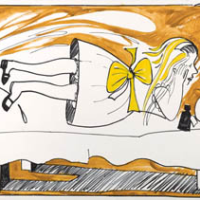45. CHARLES BLACKMAN Mr Rabbit Reads to Alice c1980

Dear, dear! How queer everything is to-day! And yesterday things went on just as usual. I wonder if I've been changed in the night? Let me think: was I the same when I got up this morning? I almost think I can remember feeling a little different. But if I'm not the same, the next question is, Who in the world am I? Ah, that's the great puzzle!
- an excerpt from Lewis Carrolls Alice's Adventures in Wonderland
The tantalising notion of a prepubescent girl bypassing her naivety to delve into existentialism is one that would fascinate and feed Charles Blackmans creative hunger for decades. Lewis Carrolls whimsical story Alice's Adventures in Wonderland was the source of the artists most regaled series and one of the most significant artistic feats of twentieth century Australian Art.
Speaking with Robert Peach in 1973, the artist recalls:
I was absolutely thrilled to bits with it [Alices Adventures in Wonderland].. and it seemed to sum up for me at that particular moment my feelings towards surrealism, and that anything could happen. The cup could lift off the table by itself, the teapot wouldpour its own tea when [Alice] passes through the mirror. The world is a magical and very possible place for all ones dreams and feelings. One is completely outside of reality This was sparked completely off by Barbaras influence on my life.1
In all of Blackmans Alice in Wonderland paintings, it is the artists wife at that time, Barbara Blackman, who is depicted as Alice. When he first began the series in 1956 Barbara was pregnant, their lives were on the cusp of great change, excitement and the sense of the unknown was palpable. Their worlds were a place of kinetic potential with ensuing chaos and adventure. With a setting like Wonderland for these themes to play out, it is no wonder Blackman created worlds that are memorable, thought-provoking, and always a little bizarre.
Mr Rabbit Reads to Alice c1980 depicts a world that challenges time, space and sanity. Spouting from the shadows behind an open door, Alice seemingly topples out of a teapot and lands nonchalantly at the table to a nonplussed Mr Rabbit (who is commonly thought to be self-representational). He scarcely looks up from his paper. A tea cup hovers. The ubiquitous bouquet and jar of ink balance on the edge of the white tablecloth while negative and positive space interchange. The implications of the title are of a still and quiet time, wherein an oversized Mr Rabbit reads to Alice, as opposed to the haphazardness of the imagery that would imply a fleeting moment. A moment in time that has been captured just fractions of a second before everything comes crashing down. The teapot smashing into pieces. Or is it suspended in air? Imminent chaos or magical wonderment is sure to follow. An instant in time pregnant with possibility. Astute, poetic and wise, Blackman has adopted the ethos of Alice; If I had a world of my own, everything would be nonsense. Nothing would be what it is because everything would be what it isn't. And contrary-wise; what it is it wouldn't be, and what it wouldn't be, it would. You see?.2 The iconography that Felicity St John Moore remarks on, are all present in the present work:
In the same way the Blackmans had identified their own surreal adventures with the Alice story, Charles would use the series to evoke his personal poetic image. The expressive figure of Alice, as Barbara, is ever present; so (usually) is the White Rabbit, as the artist, Charles, there by implication when not visible. So again is the bouquet, a symbol of creation and carnality, the flowers in the centre of the table as though for a birthday. Then there is the teapot, a pre-maternal shape with different personalities and roles; the magic bottle, or bottle of change, usually tipping/tilting on the shady side of the picture space; and of course the white tablecloth with its handy apron, at once a versatile motif and a pictorial device.3
Charles Blackmans very rare and major work Mr Rabbit Reads to Alice of c1980, represents the artist at his most characteristic. Using an effective reduced palette of white, black, and yellows the line making is free, dream-like in its imagery and confirms the artists reputation as a master of contemporary psychological painting. With this artwork, as in Lewis Carrolls bizarre and poetic Alice's Adventures in Wonderland tale, the further you go down the rabbit hole the more things become curiouser and curiouser.
Footnotes
1. Charles Blackman interviewed by Robert Peach, Sunday Night Radio Two, ABC Radio, Sunday 9 September 1973. Cited in St. John Moore, F., Charles Blackman: Alice in Wonderland, National Gallery of Victoria, Melbourne, 2005, p.10; footnote 2
2. Alice in Wonderland, Prod. Walt Disney, Walt Disney Studios, 1951
3. Smith, G. & St John Moore, F., Charles Blackman: Alice in Wonderland, National Gallery of Victoria, Melbourne, 2006, p.11
Tessa Spooner BA (Fine Art), MA (Art History & Theory)